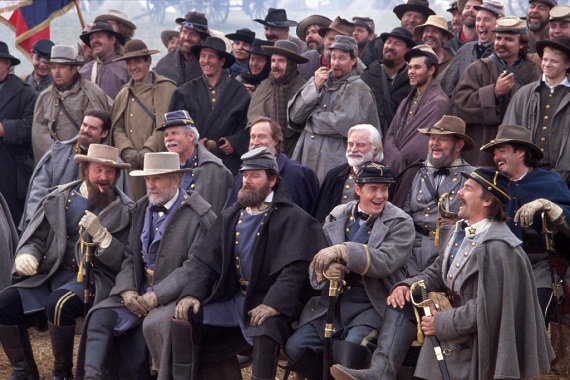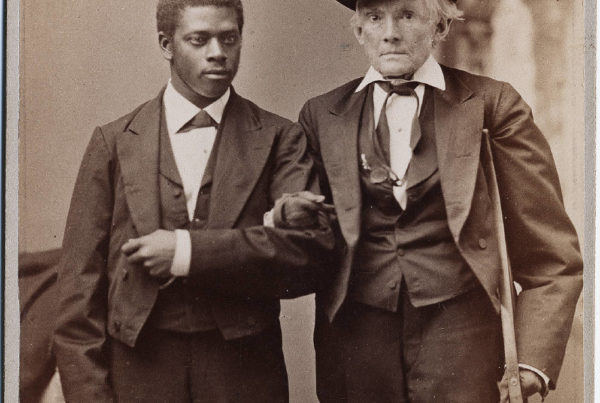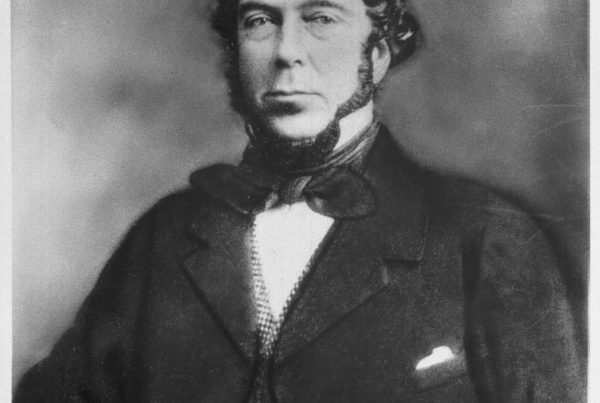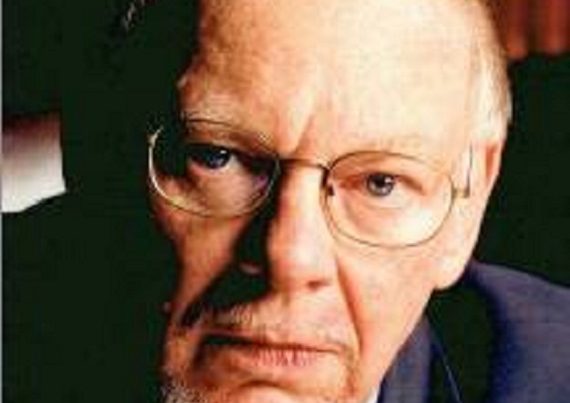The American Enterprise magazine, a slick-paper, coffee-table arm of the neocon publishing empire, has recognized the premiere of the Civil War film epic “Gods and Generals” by devoting its March issue to the Late Unpleasantness. TAE brings out some deep thinkers to examine American history 1861 – 1865 under the rubric “Just War.” (Shouldn’t there be a question mark in that title? Just for the sake of suspense, if nothing else.)
A proverbial put-down of historical works which presume to be original and important goes like this: the part that is original is not accurate and the part that is accurate is not original. The reverse is nearer true for TAE. What is new is the only accurate and interesting part: that is Bill Kauffman’s review of the movie along with his informative interview with the film’s creator, Ronald Maxwell. But then, Bill Kauffman is not a neocon but a Western New York populist stranded far from home.
Historian Jay Winik contributes a piece on the current Lincoln criticism which makes the standard, respectable case of historians who actually know something about the subject but are loath to disturb the Lincolnian nationalist mythology: Yes, some bad things happened under Abe, but they were unavoidable necessities, and after all the end justifies the means.
Dinesh D’Sousa contributes a sermon on Lincoln as “A True Philosophical Statesman” that is also standard fare. D’Sousa actually knows less about the real history, the real lived human experience, of his adopted country than I do about Paraguay.
But in ignorance is strength, because by the Straussian cult ritual, which D’Sousa here popularizes, you are not supposed to know any history. In fact, knowing history and giving it any weight is prima facie evidence of fascist tendencies. It demonstrates that you are incapable of seeing the universal principles by which proper interpretations are made. That is, the universal and eternal meaning of history is only to be obtained by Straussian exegesis of a few sentences which Straussians select, from a few documents which they select, written by a few men they select.
This methodology is perfection when one wants to sacralize Lincoln and what he wrought. All one need do is quote a few pretty phrases that evoke nationalist and egalitarian sentimentality. Though the methodology does tend to break down when challenged by the well-informed, as when Professor Harry Jaffa, in his debate with Professor Thomas DiLorenzo, was reduced to irritable denials of plain historical facts.
Most of the rest of TAE‘s “Just War”contribution to understanding the central event of American history is fluff designed to catch Civil War hobbyists, including a pointless and less-than-coherent exposition of Mr. Robert Duvall’s historical wisdom.
And now we come to TAE‘s piece de resistance, as they say, “A Class War,” by the military historian Victor Davis Hanson, who has had quite a bit of attention lately among all the Usual Suspects.
Hanson first came to notice by pointing out how Greek democracy was a product, not of theory, but of the importance to the state of the body of armed citizen-soldiers. There was not much really original about this – it is the old story of the Anglo-American yeoman—but it was useful to point it out.
Since then, Professor Hanson has gone on to writings about modern history that appear to glorify war, at least war as carried out by the armed forces of what he regards as democratic societies. This celebration (not too strong a word, I think), of the allegedly wholesome benefits of war has obviously provided comfort to the “democratic” global imperialists with which America is cursed today – and has thus made Hanson something of a celebrity.
In “A Class War” Hanson glorifies the great democratic achievements of General Sherman’s notorious March through Georgia and South Carolina in the winter of 1864-1865. Let us quote the blurb: “How 60,000 armed Midwestern men, in a 300-mile march taking less than 40 days, squashed aristocracy in America, and changed the entire psychological and material course of our national history.”
One might ask where, exactly, General Sherman got the moral and constitutional authority to change the psychological and material course of American history, but such questions do not occur to those who are preaching crusades. This is not a new story. It is the same old stamping-out-the-grapes-of-wrath rationalization: Northerners rising in righteous might to put down the treason of Southerners who, corrupted by slavery, harbored an evil desire not to want to belong to The Greatest Nation on Earth. It’s the same familiar story, but the old girl has had a make-over. She has a new hair-do and different cosmetics.
Here is a fair summary of Hanson’s description of Sherman’s March: a brave and democratic army of sturdy, idealistic Midwesterners performed a great military feat. In the process their democratic spirit was outraged by haughty Southern aristocracy and by the oppression of black people, whom they heartily embraced. As a result they resolved to destroy Southern society once and for all, and thereby bestowed on the universe a new birth of freedom.
There are so many things wrong about this paean to Sherman’s March that it amounts to a fantasy. Historians, before the era of PC, were expected to study primary sources, documents of the time, before they expounded on the meaning of historical events.
Anyone who has spent some time with the primary sources knows what a dubious characterization Hanson has made. That war was an immense event, occupying a huge area and involving several million people, and one can snip quotations to provide examples of anything one wants to find. I am referring here to the bulk and weight of the evidence and only the evidence left by Northern soldiers.
You do not have to pay heed to a single Southern testimony to understand what happened on Sherman’s March and why. It is all in the letters and diaries of the participants. I urge anyone who lives above the Ohio and Potomac to go to your local historical society or state library and read some of those letters and diaries for yourself. You will see how “A Class War” creates a fantasy of righteous virtue and intention that badly distorts the weight of the evidence.
Why would anyone who wanted to celebrate American military prowess pick out one of the US military’s most inglorious episodes, and one which involved brutality against other Americans? When there are a hundred more edifying examples?
To begin with, the march was not a military feat. What was left of the main Confederate army, after self-inflicted wounds at Atlanta, was in Tennessee trying to attack Sherman’s supply lines and deal with two huge federal armies that were holding down the people of Tennessee and Kentucky. Sherman’s advance from Chattanooga to Atlanta, opposed by a small but seasoned Confederate army, had not been so easy. The March through Georgia and Carolina was contested only by a few thousand cavalry and old men and boys of the home guard. When Sherman got to North Carolina he was met by the remnants of a genuine Southern army and was defeated by a small force at Bentonville.
Three hundred miles in 40 days against slight opposition is no feat of arms. It is rather slow progress – unless you allow for the time consumed by looting and burning out civilians. There was never any doubt as to the purpose of the March. It was to bring as much destruction as possible to the civilian population of an area of the South not previously invaded and occupied. And there is no doubt that Sherman was not acting against “aristocracy” but against the entire population. And no doubt that his motive was not “democracy, democracy, democracy,” but “authority, authority, authority,” that is, enforced obedience to government.
Many of Sherman’s men were veterans who had been occupying (and burning and looting) parts of the South for over three years. Yet we are supposed to believe that their experiences on the March suddenly opened their eyes to the evil of “Southern aristocracy” and drove them to relish its destruction. Charges of domination by “Southern aristocracy” were a part of Republican party propaganda before and during the war, but seldom a main theme. Lincoln himself never spoke of class conflict, tended to blame Northern and Southern Democratic politicians, and said: “The Southern people are exactly what we would be in their situation.” The real complaint against the “Southern aristocracy” was not elitism but the fact that they kept a brake on surrendering the federal government completely to mercantilism.
In generalizing about Southern society and the Confederate army, Hanson, alas, is in a numerous company of historians who feel free, on this subject if no other, to declaim grand interpretations on “knowledge” that consists mostly of the propaganda of one side of a conflict. (The righteous side, which is their side, of course.)
Into the heart of this allegedly class-ridden Southern society marched the great democratic army of Midwesterners, where officers and men were seen strolling arm and arm and pitching in to do the chores together. We are supposed to assume such never happened in the Confederate army, where units were all from the same neighborhood and officers were elected in the first part of the war? The clandestine insinuation is false, and egregiously so.
During the war, many Union generals, even subordinate ones, went about with a squadron of cavalry for personal escort, lavish ceremonial uniforms, and elaborate staffs and headquarters. Robert E. Lee fought the war in a colonel’s field jacket with a tent, two staff officers, and a few couriers. (Many of the Union generals were, after all, not soldiers but Lincoln’s political patronage appointees.) A foreign military observer who dined with Joseph E. Johnston’s Confederate army headquarters staff found that there was a scarcity of tableware, so that its use had to be rotated among the officers, including the commanding general.
If one wants to declare that the Union fought against “aristocracy,” then accept the obvious corollory: the Union fought not for democracy but for plutocracy. One wonders if those sturdy Midwesterners didn’t feel a little class resentment of their draft-exempt factory owners who paid them large bonuses to enlist. Or of the Wall Streeters who dined every day at Delmonico’s, lit their cigars with $50 greenbacks, and grew rich off government war contracts and loans, the tariff, and national bank charters. If Northern soldiers didn’t notice this, they were a little naive, and perhaps even deluded by propaganda.
There was, however, at least one significant difference between the top echelon of the North and the South. General Sherman complained explicitly that rich men who had sacrificed everything were fighting as private soldiers in the Confederate army, while Northern men of property showed no such willingness.
Hanson is operating with the old propaganda claim that since only a quarter of the white population was involved in slave owning, the South must have been dominated by a minority. Even worse, it was dominated by the 5 per cent of large slave-owners. (A fourth is a bigger percentage than Northerners who owned industrial or national bank stock.)
In fact, the richest planters were opponents of secession, nor did the greater part of Sherman’s March pass through the areas where they were concentrated. The South had universal white male suffrage. If Hanson really believes that the men who carried out the feats of Confederate soldiers were bossed around by a few snobs, then I invite him to spend an evening discussing the question with their descendants in a blue-collar bar anywhere from Southern Maryland to West Texas.
Hanson would have us believe that the Union army was concentrating its destruction only on wealthy estates. This is not true, and to the extent that it happened, it was because the bigger farms had more valuable loot.
Letter from a Union soldier to the home folks in Indiana, one of hundreds of a similar import:
It is a shocking sight to see how the soldiers sarve the farmers[.] Tha take everything before them[.] I saw them today go into a hous and take everything tha cood lay their hands on and then went for the chickens out adoors and the worst of all it was a poor widow woman with fore little children. I was mity sorry for her.
She begged them not to take her things for her little children would starve . . . . I have saw a heepe such cases as that tell (sic) I am tired out of such doings. . . . if I was at home I cood tell you a heepe such things as I hav seen . . . .
It is true that Sherman’s force contained many good Midwestern Americans who were doing what they believed was right. It also had larger contingents of mercenaries, criminals, and foreigners than any American army before or since. Why would such good Americans want to destroy the statue of Washington at the South Carolina capital and burn up William Gilmore Simms’s library with its hundreds of irreplaceable manuscripts of Washington, Nathaniel Greene, Francis Marion, and other Revolutionary heroes?
Or destroy churches and schools and convents? Put pistols to the heads of women and black servants to frighten them into disclosing the whereabouts of the valuables? Open fresh graves (of which there were a great many in the South) as possible hiding places for silver and jewelry. Or, like the foreign-born, syphilitic Union general Kilpatrick, force women to dance to gay tunes with his men while their homes and their town was being forever wiped off the map by fire. Or tear up little girls’ dolls and nail the family pet to a door? One Georgia lady was visited by several wives of Union officers who choosily selected and divided up her possessions. When she protested she was called a spy and sent without ceremony to a brutal prison in Tennessee.
The simple and ought-to-be-obvious truth is that the Confederate army, an extended network of kinsmen, neighbors, and friends fighting the invaders of their country and the threateners of their freedom, much more resembled Hanson’s ideal citizen soldiers than did the forces of the federal government.
Union soldiers fighting to destroy aristocracy? In letters by the hundreds, in the midst of campaigns and nearly to the end of the war, Northern soldiers blamed the war on abolitionists and Lincoln! I believe these men greatly outnumbered Hanson’s starry-eyed idealists destroying “aristocracy.”
General Sherman writes General Grant:
the amount of plundering, burning, and stealing done by our own army makes me ashamed of it. I would quit the service if I could for I fear we are drifting toward vandalism . . . .thus you and I and every commander must go through the war justly chargeable of crimes at which we blush.
Some crusade for democracy.
Professor Hanson is certain that after Sherman had passed on his way, “every child of the South knew that the will of the Confederate people, as well as their army had been crushed.” This is not strictly true, but more to the point, we are assured, that ” Sherman killed very few, and with genuine reluctance. Rapes during the march were almost unknown.”
If Professor Hanson wished to tell us that Sherman’s March was a mild affair compared to the Rape of Nanking or to the Nazis and Communists in Poland, and that not all Union soldiers were guilty of atrocities and many were shamed by what they did or saw, then he would have a point. But the statement as it stands, by the standards of the time, is absurd.
Prussian officers were shocked by the accounts of Union campaigns, and indeed, in the Franco-Prussian war which followed a few years later, there was no deliberate war on private persons and property. Thirty years after the war the American public was outraged by the newspaper accounts of of the methods of the Spanish General “Butcher” Weyler in Cuba. But Weyler was merely applying what he had learned as an observer with the US army during the Civil War.
It never seems to occur to Sherman apologists, that when a plantation, or a whole agricultural area, is devastated, not only the white women and children but the much more numerous blacks are left without food and shelter. It is true the Union army fed some refugee slaves, but no one knows to this day how many more thousands of the uprooted died in the wake of the devastation. Just the masses of wantonly killed livestock left a disastrous ecological and public health situation.
Nevertheless, for the next twenty years newspapers will be reporting that: “Distinguished military historian Victor Davis Hanson has proved that Union army atrocities were negligible and largely the creation of frantic Southern propaganda.” Such is the reign of PC.
One can know for certain that our historian is working from his active imagination rather than from historical sources by his treatment of the subject of cotton:
The pragmatic Sherman scoffed at these paternalistic rationalizations. [Huh?] He demonstrated how much he thought cotton was really worth to the United States when one head of local Confederate forces in South Carolina offered to cease burning cotton if Sherman’s men would in turn stop torching estates. Sherman replied: “I hope you will burn all the cotton and save us the trouble. We don’t want it;it has proven a curse to our country. All you don’t burn, I will.
What Hanson wants us to learn from this quote is sheer unfounded silliness from beginning to end. The Confederate officer offered to stop burning cotton, which he knew the Northerners lusted after, if Sherman would stop burning houses, not “estates.” Cotton was the most valuable commodity in North America and had made up the bulk of American exports for decades previously. Sherman’s statement was merely one of his frequent attempts at dark-humor hyperbole. Northerners wanted cotton very much. This is why federal generals and officials stole literally millions of bales of it during and after the war. At that very moment, some of Lincoln’s biggest industrial supporters were buying cotton illegally from the Confederates in exchange for materiel.
We come at last to the worst but also the hoariest part of the Hansonian fantasy history. We are told that the Union army on this expedition was characterized by “revulsion” against Southern aristocracy and that we are to rejoice in “the Union army’s embrace of the slaves.” False, on the overwhelming weight of evidence.
Sherman’s soldiers did not feel a lot of revulsion at Southern whites, except for some of the most backward and isolated people perhaps, though they often found them unfamiliar. Mostly they felt irritation at the continued stubborn recalcitrance of all classes of the population to being conquered and governed by Northerners.
To say that Sherman’s army “embraced” the slaves is to propose a proposition that is laughable to any body who will spend half a day with the primary sources. When Northern soldiers felt “revulsion” it was for the slaves. Amidst the flames of Columbia, federal soldiers were seen often driving away blacks with blows: “We are Western men and we don’t want your damned black faces among us.” This is far more representative of what happened than a happy tale of friendly GIs in blue handing out candy bars to children.
One could easily compile a volume of Union soldiers’ unfriendly and unflattering comments on the black people of the South that would rival the collected works of Joseph Goebels for racist invective. This sentiment was stronger and more widespread than what genuine compassion there was.
Blacks were robbed and killed as readily as whites, and could be beaten without reserve. Black women were more vulnerable to rape and rape-murder than white. The army, it is true, absorbed part of the black refugee population, while raising their status to that of camp laborers, and servants and concubines of Union officers. And, of course, each able-bodied black man enlisted in an all-black regiment saved one Massachusetts or Connecticut Republican from having to dirty his hands in the service.
Hanson’s Sherman is just a crusty old Walter Brennan, tough on the outside but with a heart of gold within. He sometimes complained about the masses of refugee blacks interfering with army operations, but really he “embraced” them and fed them.
Not at all a fair characterization of Sherman’s well-documented attitude, which was a desire to eliminate Africans out of the pure white man’s country he was fighting for, and in the meanwhile to keep them hard at work.
But perhaps we should not blame TAE and its writers too much. They are giving the customers what they want, and they will find many takers. A more basic question is why do so many Americans, or at least American “spokespersons,” feel compelled to force our history into a pattern of collective self-glorification? All peoples tend to mythologize their important experiences, but it would be hard to find one more self-righteous and uncritical and so much in need of cosmetology as triumphal American exceptionalism. History, after all, is the remembrance of the usually ambivalent and complicated struggles of us poor fallen creatures in a fallen world. As two of Faulkner’s characters say to each other, in contemplating the human race: “the poor sons of bitches.”
I think the sanitizing of evil comes from the deformed Christianity of Puritanism, which was planted in Boston in the 17th century and has been a cancerous growth in America ever since. (Though, of course, material interests always play a part as well.) I am of the elect, so it goes, and therefore my will is righteousness, and undoubted righteousness is my license to annihilate the unelect. Or in the public form: America = Democracy = God. That’s my hypothesis, though I’ll gladly listen to yours.
Clearly, this kind of thing is stronger at some times than others, and sometimes it sweeps all before it. And clearly it is a rising curve in the United States today, which Professor Hanson has caught and is riding. And even more basic question is what does this kind of militant self-righteousness portend for us, both concretely and morally?
Copyright © 2003 LewRockwell.com. Reprinted by permission.






